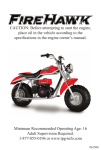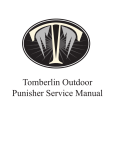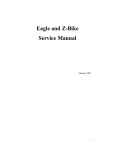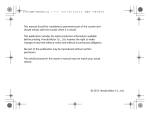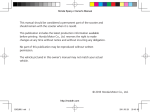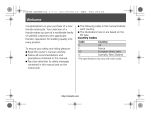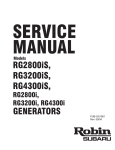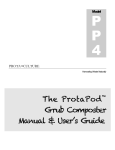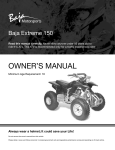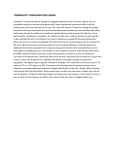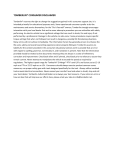Download 1-877-855-0196 or www.tpg-info
Transcript
1-877-855-0196 or www.tpg-info.com Tomberlin Product Group LIMITED WARRANTY The Warranty Registration Card For This Kart Must Be Filled Out and Returned To The Manufacturer. The warranty registration for this vehicle may be filled out by: returning the warranty registration insert in this manual, registering online at www.tpg-info.com, or telephone at 1-877-855-0196. Please have the following information ready when registering your product: ENGINE NUMBER VIN NUMBER (Located on the engine casing) (Behind Driver’s seat on frame) __________________________ _________________________ DATE __________________________ STORE NUMBER (See Receipt) _________________________ The following warranty only applies to vehicles which after being unloaded from their original packaging, assembled as described in this manual, and under normal use, conditions, and service are found to have defects in manufacturing and workmanship that are not the operator’s fault. The limited warranty covers the frame, suspension, steering, brakes, engine, and engine related components for a period of ninety (90) days from the date of purchase. This warranty only applies to the original purchaser of this product. This warranty does not cover items such as tires, batteries, belts, brake pads, or any other components that wear under normal use. This warranty also does not cover items that the seller deems defective due to improper care, improper assembly, modifications, abuse, or accidents. All warranties are voided if the vehicle has been altered in any way, or meets any of the following criteria: 1. Contains parts deemed “non-original” replacement parts. 2. The vehicle serves as a rental unit. 3. The vehicle is altered, affecting performance, safety, and/or reliability 4. The vehicle is used in competitions or races. 5. Wheels are bent or broken due to impact. Do NOT return this unit to the retailer. Many problems that arise are easily repaired by the consumer or service center. For parts and service, please contact our customer service representatives at 1-877-855-0196 or www.tpg-info.com. i Foreword Congratulations on your purchase of the CrossFire 150 go-kart. Tomberlin Product Group wishes you many exciting moments with your new off-road vehicle. The CrossFire 150 combines the joy of off-road driving with state of the art engineering to provide customers the best possible product. This manual contains assembly, operational, safety, warning, and maintenance information that will help prolong the life of the vehicle and promote safe driving amongst all users. In reading this manual, please note the sections that deal with safety while driving and tips that will help drivers deal with different driving conditions. Carefully read this entire manual before driving, or allowing others to operate and/or ride in this go-kart. Failure to thoroughly read and understand this manual may result in severe injury or death to drivers and/or passengers. Tomberlin Product Group wishes all drivers a safe, enjoyable experience with the CrossFire 150. Carefully read the section dealing with maintenance and be sure to fill in the chart showing scheduled maintenance and service. Servicing and maintaining this vehicle using the provided schedule will improve longevity and allow for a more joyous experience. It is important that this manual remain with the go-kart in the event that it is sold. It provides important information and warnings that will help keep all off-road enthusiasts safe. If the manual is lost or damaged, please call 1-877-855-0196 or www.tpg-info.com for a replacement. Assumption of Risk The owner/operator of this go-kart, and all passengers who may ride assume responsibility for all risks and/or incidents arising from its use. Failure to follow guidelines and warnings set forth in this manual may result in serious injury or death. ii Table of Contents Warnings........................................................1 Warning Decals..............................................2 Safety Operation Guidelines..........................3 Unpacking Parts.............................................7 Parts List........................................................8 Brush Guard Padding.....................................9 Filling The Battery........................................10 Charging The Battery....................................12 Assembly.......................................................13 Installing The Battery....................................25 Replacement Batteries..................................25 Before Each Ride..........................................26 Driving..........................................................30 Maintenance..................................................35 Important Information..................................42 Trouble Shooting..........................................46 Wiring Diagram............................................47 California Emissions.....................................48 Kart Specifications........................................50 Notes.............................................................52 iii WARNING: Read the entire manual before operating this go-kart. Be sure to carefully read sections dealing with safety, warnings, and special instructions. WARNING: This vehicle is intended for OFF-ROAD USE ONLY. Before operating this vehicle, read all of the instructions for safe assembly and operation as well as the instructions governing the engine and other portions of the vehicle. Pay close attention to all caution and warning labels on the go-kart. WARNING: Hearing protection is required while WARNING: You must depress the brake pedal before operating this unit. the engine will start. WARNING: To avoid serious burns or injury, always use caution when working with gasoline. The engine should only be refueled while it is not running and outdoors in a well ventilated area. Avoid spilling gasoline anywhere. If gasoline comes in contact with skin or clothing, immediately wash it off with soap and water and change clothes. Do NOT smoke near or expose the gasoline to an open flame. Follow all gasoline producer directions and be sure to tighten the fuel cap after fueling. WARNING: The maximum combined weight for driver and passenger is 400 pounds. 1 2 Safety Operation Guidelines 1. This manual is NOT intended to serve as a service manual for the CrossFire 150. This manual provides instructions for assembly, maintenance, and general operation. 2. The CrossFire 150 should only be assembled by persons with the necessary skills to properly read, understand, and follow mechanical instructions. 3. When working on areas of the go-kart away from the engine, remove the spark plug to prevent the engine from starting. If working on or near the engine, avoid the muffler and other hot areas around the engine. 4. Use extreme caution when working on an engine that has been in use. Engine components will be extremely hot. 5. Do NOT attempt to modify or change any of the original equipment on the CrossFire 150. The removal of any parts or components could render the vehicle unsafe or in violation of state laws. 6. Before each use, check all hardware on the vehicle to ensure that it is safe to use. Check all connections, cables, bolts, locknuts, and other parts prior to use. 7. It is not possible to obtain a license for this vehicle. This vehicle is only to be used on private property or areas where local laws permit. To prevent accidents, avoid areas where other recreational vehicles are operating. Do not use the CrossFire 150 on any location without proper permission. 3 8. All persons under 18 years of age must have parental supervision at all times while operating or riding as a passenger in the CrossFire 150. 9. Do NOT operate this vehicle while under the influence of alcohol, drugs, or any substance that may impair one’s ability. Operating the vehicle under these circumstances may cause harm to yourself and/or others. 10. Do NOT attempt to use this vehicle if you have no prior experience driving. If you have no prior driving experience, please take the time to practice and learn basic driving techniques before operation. 11. Before each use, ALWAYS inspect the kart using the guidelines in this manual. 12. ALWAYS check the fuel level before starting the CrossFire 150. Do NOT fill the gas tank while the motor is running or still hot. While filling the tank, avoid enclosed places and open flames. 13. Tire pressure should be checked before each use. Improper tire pressure may cause unstable conditions while operating the CrossFire 150. Tires should be inflated between 10-12 psi. 14. The CrossFire 150 should NEVER be started unless the throttle is in idle position. The driver MUST be seated before attempting to start the vehicle. Do NOT attempt to start the vehicle unless all riders are seated with their safety harness fastened. Always keep your foot on the brake while attempting to start the vehicle. 15. Engine components become extremely hot. Do not touch the engine while the vehicle is running or while attempting to start the vehicle. 4 16. The brush guard surrounding the driver and passenger is not intended to serve as rollover protection. Before each use, be sure that tubes are securely in place by checking for loose bolts. 17. Although headlights are functional, they are not intended for driving at night. This vehicle is designed for operation during daylight hours. 25. ALWAYS slow down for turns. Excessive speed in turns may cause the vehicle to flip or roll. In some cases, excessive speed can lead to the driver losing control. Use Caution when operating on or around hills or obstacles. 26. Failure to slow down while turning may cause injury to the driver and passenger. 18. Due to the poisonous nature of carbon monoxide, this vehicle should NEVER be started or operated indoors. Carbon monoxide is an odorless, tasteless gas found in engine exhaust fumes. 27. This vehicle does not operate the same on all driving surfaces. Operate ONLY on familiar terrain. If operating in the rain, the CrossFire 150 will require additional space to brake. 19. Do NOT race this vehicle. The CrossFire 150 is not designed for racing or use on rental tracks. 28. Slow speeds are necessary when operating the vehicle on wet, slick, rough, or steep terrains. WARNING: Excessive speed in these conditions may cause bodily harm to the driver, passenger, or those nearby. 20. This vehicle is designed to hold ONE driver and ONE passenger. No person should ride on this vehicle unless properly seated with the safety harness securely fastened. 21. If driving without a passenger, fasten the passenger safety harness to prevent it from getting caught in moving parts. 22. Do NOT operate this vehicle unless wearing proper clothing. Proper clothing includes but is not limited to: helmets approved by the proper agencies, face guards/goggles, closed toe shoes, and other protective clothing. 29. Do NOT attempt to roll, flip, spin-out, or jump while operating the CrossFire 150. Forcing the vehicle into these conditions may cause bodily harm and/or damage to the vehicle. 30. When the vehicle is not in use, the engine should be turned off, the parking brake engaged, and the fuel petcock turned to off. 23. The recommended minimum age for drivers and passengers in this vehicle is 16 years. Ability to operate this vehicle safely depends on the drivers/passengers age, experience, size, understanding, and mental and physical capabilities. 5 6 Pads (set) (1) Gas Tank (2) (1) (2) Side Rails Front Support (1) 7 (1) 1. Remove all loose parts and place in an open area where they are easily accessible and will not be damaged. It may be necessary to cut the zip ties to access all loose parts. 2. After all loose parts are removed, begin assembling the go-kart. 3. All loose parts are listed below. If you are missing any parts, or require assistance in your assembly process please contact us at 1-877-855-0196 or www.tpg-info.com 4. Please refer to the parts list on the following page. Rear Support Tube Unpacking Rear/Center Support (1) Front Bumper The first step in preparing your CrossFire 150 for driving is removing the parts from the shipping box. Your CrossFire 150 should resemble the picture below when the top and sides of the box are removed. See Figure below. Headrest (2) Side Supports (1) Set (4) Tires Unpacking Parts Before First Ride Brush Guard Padding Before assembly, place the tubular pads in their proper locations. The three pads needed for this step are long and have no writing on them. Locate the two (2) Side rails and place a pad on each as shown below. Locate the Rear/Center Support and place a pad on it as shown below. Be sure that the pads are secure along their seam and tied tightly into place. Place these parts back with the others after the pads have been properly installed. Filling The Battery The following procedure should only be performed by an adult utilizing extreme caution. While attempting this procedure, individuals should wear rubber gloves, eye protection, and have water available in case the electrolyte solution comes into contact with skin or eyes. Children should not attempt to complete this procedure, and should NOT be allowed near the area when attempting to fill the battery. This procedure should be completed first so that the battery is charged when the kart assembly is complete WARNING: (x2) There are four locations on the frame of the go-kart that need to have pads attached. For assembly, be sure to use the two pads with the CrossFire writing and the two short pads. See figure below for proper locations. Be sure that the pads are secure along their seams and that they are securely tied in place at each end. 9 POISON - CAUSES SEVERE BURNS Contains sulfuric acid. Avoid contact with skin, eyes, and clothing. To prevent accidents, rinse the empty electrolyte solution container with water after use. - If solution comes in contact with the skin, flush the area with water. - If solution is swallowed contact a physician immediately. - If solution comes in contact with the eyes flush with water for fifteen minutes. Get immediate medical attention. KEEP OUT OF REACH OF CHILDREN Procedure - This procedure should be performed in a location out of reach of children and animals. - Remove the battery and the electrolyte solution from the shipping crate. (See figures on page 12 to assist with this process) - Place the battery on a level surface and remove the metallic sealing from the top. - Holding the electrolyte container upside down so the sealed openings are facing the ground, align each sealed opening of the bottles with the corresponding openings on top of the battery terminal. - Strongly push the electrolyte container into the openings of the battery terminal so that the all of the seals on the electrolyte container break, allowing electrolyte solution to flow into the battery. Do NOT attempt to puncture the electrolyte container unless the six sealed openings are properly aligned with the six openings on the top of the battery terminal. 10 - Air bubbles will begin rising from each opening of the electrolyte solution when they are punctured. - If air bubbles are not rising in each individual tube, tap the top side of the electrolyte bottles. - Leave the electrolyte bottles in their draining position until all of the electrolyte solution has drained. Do NOT attempt to remove the electrolyte bottles while they are draining. - Do NOT attempt to puncture or cut any part of the electrolyte container. - Do NOT allow children near the battery at any point during the installation process. - When the electrolyte solution has finished draining, pull the bottles gently from the top of the battery terminal and properly discard in a location out of reach of children or animals. - The battery needs to sit for Thirty (30) minutes before charging. Letting the battery sit will allow the electrolyte to penetrate the plates and provide a longer battery life as well as better battery performance. - After sitting for thirty (30) minutes, the battery is ready for charging. Place the cap strip loosely over the holes in the top of the battery. Do NOT push the caps all the way into the holes. - After the battery has been sitting for thirty minutes, push the caps firmly into place in the holes. This will seal the battery. Do NOT attempt to remove the caps after sealing the battery. 11 1 2 3 4 5 6 7 8 12 WARNING: Do NOT open sealed caps to add water to the battery. - Batteries contain sulfuric acid. Eye protection should ALWAYS be used when working around battery acid. - If battery gets hot to the touch while charging, immediately remove from charging and allow battery to cool down. - While attaching the red and black cables for charging, be sure that the charger is not plugged into the outlet. - Charge the battery in a well ventilated area out of reach of children and animals. - Do NOT smoke around batteries - Do NOT expose batteries to open flames Charging The Battery - The battery must be charged before use. - Connect the positive (+) red clamp from the battery charger to the positive (+) pole of the battery. - Connect the negative (-) black clamp from the battery charger to the negative pole of the battery. - Do NOT plug the charger into the outlet until the clamps have been placed in their proper location on the battery. - The battery should charge between 500-700 milliampere for 6-10 hours. - When the battery has finished charging, unplug the charger from the outlet, then proceed to remove the clamps from the charger. - Press down firmly on the cap strip to slide it into place. Do NOT hammer or strike the caps to force them into place. - Do NOT attempt to remove the electrolyte caps after sliding them into place. Assembly Rear Shocks The rear shocks have two positions; shipping and operating. The shocks must be moved from the shipping position to the operating position before the kart may be driven. To prevent damage to the 13 kart and possible injury to operators/riders, Do NOT operate this kart unless the rear shocks have been placed in the operating position. The rear shocks must be adjusted before the go-kart is operated. The rear shocks are located on each side of the kart, next to the engine. To adjust the rear shocks, remove the bolt holding the bottom of the shock in place and move the shock to the opening in the bracket directly in front of the position in which the unit was shipped. Be sure to tighten the bolt to ensure that the shock will not slide out of place during operation. To prevent damage to the kart or severe injury to passengers, the rear shocks must be moved. WARNING: Do NOT attempt to move the shocks if the kart frame is not supported. If the kart frame is not properly supported, it could fall causing serious injury. Front Tie Rods The front tie rods need to be attached to the spindle on each side. To do this, remove the washer, castle nut, and cotter pin from the tie rod. Slide the bolt on the tie rod down through the hole in the spindle so that the threads are sticking through the bottom. Place the flat washer, spring washer, and castle nut on in that order. Tighten the castle nut. Be sure that the hole in the bolt that the cotter pin slides into lines up with openings in the top of the castle nut. This will allow for the cotter pin to slide into position. After sliding the cotter pin through the castle nut openings and the hole in the bolt, bend the end without the curve (one side at a time) to a ninety (90) degree angle (away from the center) to prevent it from sliding out of place. Repeat this process for the tie rods on each side of the kart. Do NOT operate this go-kart without attaching the tie rods as shown. 14 Front Tires Front Tire Size - 19 x 7-8 In order to assemble the tires, you will need to raise the front end of the go-kart. Be careful not to damage any kart components while raising the front end. Remove the nuts from the front wheel hubs before attempting to place the tire on. The tires for this kart are directional tires. In order to ensure that the tires are assembled correctly, place the tires on the hubs so that the valve stem is on the side of the tire facing outward, and the directional arrow rotates towards the front of the go-kart. To slide the tires on, align the holes in the rims of the tires with the bolts on the front wheel hubs. Place the nuts on the bolts and evenly tighten using a socket wrench. When tightening, bolts should have a torque value between 22-29 ft/lbs. IMPORTANT: The air pressure in the front tires should be between 12-14 psi. Rear Tires Rear Tire Size - 22 x 10-10 The rear of the kart needs to be raised in order to place the rear tires on. Be careful no to damage any kart components while raising the rear end. Remove the nuts from the tire hub before attempting to place the tire on. In order to ensure that the tires are assembled correctly, place the tire on the hub so that the valve stem faces outward, and the directional arrow rotates towards the front of the go-kart. To slide the tire on, align the holes in the rim of the tire with the bolts on the rear wheel hubs. Place the nuts on the bolts and evenly tighten using a socket wrench. When tightening, the bolts should have a torque value between 22-29 ft/lbs. IMPORTANT: The air pressure in the rear tires should be between 12-14psi. 15 Brush Guard Driver Side Support 1. Remove the bolts and spacers from the two holes needed to place the driver’s side support into place. (See Figures Below) 2. Place the long tubular section (removed from the driver’s side while unpacking) on the kart so that the curved end of the tube slides over the end of the tubing on the kart. 3. Place the other end of the tubing over the tube next to the front shock that the bolt and spacers were removed from. Be sure to align the holes in all tubing to ensure that the bolt will slide easily through. 4. Place a spacer on each side of the tube at both locations. Be sure that the curve in the spacer lines up against the curve of the tube. Slide the bolt through the pre-drilled holes so that the threads are facing the inside of the kart. Be sure that the bolt slides through the holes in both tubes and both spacers. 5. Hand tighten the bolts to hold the tube into place. Allowing slight movement in the brush guards will allow for easier assembly. 16 Passenger Side Support 1. Remove the bolts and spacers from the two holes needed to place the passenger’s side support into place. (See Figures Below) 2. Place the long tubular section (removed from the passenger’s side while unpacking) on the kart so that the curved end of the tube slides over the fitting located behind the passenger’s seat. 3. Place the other end of the tubing over the fitting behind the front shock on the passenger’s side that the bolt and spacers were removed from. Be sure to align the holes in all tubing to ensure that the bolt will slide easily through all pre-drilled holes. 4. Place a spacer on each side of the tube at both locations. Be sure that the curve in the spacer lines up against the curve of the tube. Slide the bolt through the pre-drilled holes so that the threads are facing the inside of the kart. Be sure that the bolt slides through the holes in both tubes and both spacers. 5. Hand tighten the bolts to hold the tube into place. Allowing slight movement in the brush guard will allow for easier assembly. Front Support 1. The front support is the larger, single tube with bolts in both ends. 2. Remove the bolts and spacers from each end of the tube. 3. Place the front support in between both side supports. Align the holes in the ends of the front support with the pre-cut holes in each side support. 17 4. Be sure that the rounded caps located on the ends of the front support tube fit around each side support. 5. With the holes in all tubes aligned, hand tighten the bolts into place on each side. Be sure that the spacer is located on the outside of each side support and fits rounded edge against the tube. Rear/Center Support Tube 1. The rear/center support tube is “T” shaped and has a bolt in both ends of the crossbar. 2. Remove the bolts and spacers from each end of the crossbar. 3. Remove the bolt and spacer from the third contact point centered directly behind the seats. 4. Slide the bottom of the Rear/Center support tube over the third contact point. (See Figures Below) 5. Align the ends of the Rear/Center support crossbar with the pre-drilled holes in the side supports. Be sure to align using the rear holes in the side supports. 1 1 2 2 3 3 18 6. With the holes in all tubes aligned, hand tighten the bolts into place on each side of the crossbar. Be sure that the spacers are located on the outside of each side support and fit rounded edge against the tube. 7. Place the bolt through the aligned holes in the third contact point. Be sure there is a spacer on each side of the tube and that it fits rounded edge against the tube before hand tightening the bolt into place. Rear Light Bar 1. Locate the rear light bar sitting on the engine frame. 2. Remove the bolts and spacers from the ends of the bar. 3. Place the rear light bar in between the side supports aligning the holes in the end of the rear light bar with the pre-drilled holes in the side supports. 4. Be sure to use the pre-drilled holes located at the very rear of the kart. (See Figures Below) 5. Be sure that the rounded caps located on the ends of the rear light bar tube fit around each side support. 6. With the holes in all tubes aligned, hand tighten the bolts into place on each side. Be sure that the spacer is located on the outside of each side support and fits rounded edge against the tube. Rear Support Tube 1. The Rear Support tube is the small, single tube with bolts in both ends. 2. Remove the bolts and spacers from each end of the tube. 3. Place the rear support in between both side supports utilizing the pre-drilled holes directly behind the Rear Light bar. Align the holes in the ends of the rear support with the pre-cut holes in each side support. 19 4. Be sure that the rounded caps located on the ends of the front support tube fit around each side support. 5. With the holes in all tubes aligned, hand tighten the bolts into place on each side. Be sure that the spacer is located on the outside of each side support and fits rounded edge against the tube. Side Rails 1. Remove the bolts from the ends of the side rails. 2. To connect the side rails, locate the pre-drilled holes in the side tubing located above the seat. (holes are located above the passenger’s and driver’s seats in the side tubes) Be sure to attach one side at a time starting with the driver’s side. 3. Slide the bottom of the side rail over the fitting located on the kart frame beside the seat. 4. With the holes in all tubes aligned, hand tighten the bolt into place. Be sure that the spacers are located on the outside of the side support and fit rounded edge against the tube. 5. Align the top of the side rail with the pre-drilled hole in the side support tube. The pre-drilled hole is located above the seat in the side support tube. 6. Repeat this process for both sides of the kart. (See Figures on the following page) 20 Gas Tank The gas tank attaches to the frame at four points above the engine. Standing behind the kart, locate the pre-drilled holes in the cross tubing above the engine on the right side. Remove the bolts and washers from the holes in the tank. Align the pre-drilled holes on the tank with the pre-drilled holes in the tubing. (See figures below for proper tank location) IMPORTANT: When aligning the tank, be sure that the tank valve is on the right hand side when looking at the tank from the back of the go-kart. For each of the four holes, place a bolt through the top of the pre-drilled tubing hole. Below the pre-drilled hole in the tubing, place a washer, a spring washer, and a nut on the bolt. Tighten the nut securely on the bolt. Do NOT over-tighten the nuts. Doing so will cause the rubber spacers to rip. 21 WARNING: To prevent dangerous conditions, check the bolts holding the tank into place before and after each use. After the tank is securely in place, attach the gas line to the gas valve on the bottom of the tank. The gas line should run from the engine to the bottom of the gas tank. The gas valve has three settings: On, Off, and Reserve. In the On position, the kart will use approximately half the gas in a full tank before cutting off. The On position requires the arrow on the indicator switch to be facing up. Switching the tank to reserve will allow the driver to use the remainder of the gas in the tank. The reserve position requires the arrow on the indicator switch to be facing down. The valve should always be switched to the “off” position when the kart is not in use. The Off position requires the arrow on the indicator switch to be facing right (at a 90 degree angle). Front Bumper The front bumper attaches at four points on the front of the go-kart frame. Be sure that the front bumper slides on as shown. Align the pre-drilled holes in the frame with the pre-drilled holes in the front bumper. Holding a spacer on each side of the pre-drilled hole (be sure that the groove in the spacer fits around the tubing), slide a bolt through the top spacer, through the pre-drilled holes, and through the bottom spacer. Take the nut and tighten it down on the bolt. Do NOT over tighten the nut. Repeat this process for the top two points of contact. The bottom points of contact require inserting a bolt into each pre-drilled hole. Insert a bolt through the pre-drilled holes in the frame and into the front bumper. Be sure that the bolts are inserted so that the threads stick out the front side of the kart frame. Tighten the bolts. (See figures below and on the following page) 22 Front Lights To connect the front lights, locate the plastic connector on the wire coming from the front lights mounted on the left-hand side of the front bumper. Next, locate the plastic connector on the wire coming from the kart located on the frame next to the front bumper mounts. Connect these two plastic fittings. Headrest Holding both shoulder straps of the four point harness in between the holes for the headrest, slide the metal rods on the headrests into the openings on the top of the driver’s and passenger’s seats. Be sure that both metal pieces slide into the holes on the tops of the seats. IMPORTANT: Be sure that both shoulder straps on each side are in between the metal rods of the headrest before assembling. IMPORTANT: For the safety of the driver and passenger, do not operate the CrossFire 150 if the headrests are broken or no longer attached, please contact customer service to order a new headrest. Steering Wheel The steering wheel is in a “shipping” position and will need to be adjusted before attempting to operate this vehicle. Do NOT operate this vehicle without adjusting the steering wheel out of the “shipping” position. To adjust the steering wheel, locate the four bolts holding the adjustable plate to the kart frame. Loosen these bolts so that the plate will rotate and allow the steering wheel to be placed in a safe operating position. It may be necessary to adjust the steering wheel depending on the height of the driver. After the steering wheel has been adjusted, tighten the bolts to prevent the steering wheel from moving while the kart is being operated. (See figures on the following page for proper adjustments) 23 WARNING: Before attempting to operate this vehicle, be sure to tighten all loose bolt connections. Do NOT attempt to operate this vehicle with hand-tightened, or loose bolt connections. 24 Installing The Battery - Place the battery into the battery tray located in front of the engine on the passenger’s side. Be sure that the rubber mat is laying on the bottom of the tray between the tray and the battery. - The warning label on the battery should be facing the warning label on the battery tray. - Be sure to connect the negative side of the battery before connecting the positive side. - Attach the negative (-) black wire to the negative terminal on the battery. Attach the positive (+) red wire to the positive terminal on the battery. - Cover the battery with the grey cover. Be sure to slide the wires through the openings in the cover. - Secure the battery into place using the hooks on both ends of the strap. Strap comes with two hooks to fit replacement batteries. For the provided battery, use the middle hook. Fold the excess strap against the battery and attach remaining two hooks to their contact points. Utilize the proper hooks depending on battery size. Replacement Batteries YUASA - YTX7L-BS 12 Volt 6 Amp 85 Cold Cranking Amps 4(1/2) in Long x 2(13/16) in Wide x 5(1/16) in Tall YUASA - YTZ7B-BS 12 Volt 6 Amp 90 Cold Cranking Amps 4(1/2) in Long x 2(13/16) in Wide x 5(3/16) in Tall YACHT - CT7B-4 12 Volt 6.5 Amp 90 Cold Cranking Amps 4(1/2) in Long x 2(13/16) in Wide x 5(3/16) in Tall POWER MAX - GTX7L-BS 12 Volt 6 Amp 90 Cold Cranking Amps 4(1/2) in Long x 2(13/16) in Wide x 5(3/16) in Tall 25 Before Each Ride Do NOT attempt to operate this vehicle unless you: 1. Have proper adult supervision if you are under the age of 18. 2. Read this manual and understand the warning labels. 3. Have an understanding of all the controls and how to properly operate them. 4. On every ride in this vehicle, it is important that the driver and passenger both wear their safety harness. WARNING: Operating this vehicle without wearing an approved motorcycle helmet, eye protection, and protective clothing could increase your chances of head and/or eye injury, and the possibility of death in a severe accident. Always wear an approved motorcycle helmet that fits properly, eye protection (goggles or face shield), gloves, boots or closed toe shoes, long-sleeved shirt or jacket, and long pants. Driving Gear Drivers and passengers should wear helmets at all times while operating this vehicle. Helmets should be approved by an organization (DOT, SNELL) and contain a label with said approval. Goggles or a face shield should also be worn to protect operator’s and passenger’s eyes and help improve sight. To protect the body, all drivers/passengers should wear boots or closed toe shoes, gloves, long sleeved shirt or jacket, and long pants along with the suggested helmet and goggles. For added safety, purchase motorcycle boots, off-road motorcycle gloves, as well as clothing with built in padding. (Motorcycle driving pants, driving jersey, and chest protector) WARNING: Allowing a person under the age of 16 to operate this vehicle could be hazardous or result in severe injury or death. Operating or becoming a passenger in this vehicle, or any other vehicle, which is not recommended for his/her age could result in loss of control and could result in severe injury or death. A minor under 18 should have adult supervision while operating this kart. 26 Check The Oil To check the oil, remove the dipstick from the engine. (See Figure below) Wipe clear any oil from the dipstick and place it back in the hole it was removed from. Do NOT twist the dipstick back into place, doing so will give you a false reading. Push the dipstick down until the threads on the cap prevent it from going any farther. Pull the dipstick out and check the oil level. If additional oil is needed, please refer to the maintenance section of this manual for directions on how to add/change the oil. After checking the oil, be sure to screw the dipstick back into place. Tires Check the air pressure in the tires. The air pressure in the tire should register 12-14 psi with no driver/passenger. Inspect the tire for loose bolts, worn spots, and damage. Do NOT operate the go-kart with any damaged, worn, or loose components on the tire. If you have any questions, contact our customer service line at 1-877-855-0196 or www.tpg-info.com. Undercarriage Before operating the CrossFire 150, check the bottom of the unit for grass, dirt, and/or objects that could catch fire. Remove these objects or any debris that is stuck to the bottom. Failure to remove debris could result in fire or injury. Cables Be sure that all cables are secured and in place. Do NOT operate the go-kart if cables are loose or hanging. Check all connectors to ensure that they are firmly in place. Check The Fuel To check the fuel level, remove the cap from the tank and observe the amount of fuel. If more fuel is needed, using a funnel proceed to add gas to the tank until it is full. Do NOT overfill the tank, doing so may cause damage to the kart or increased risk of fire. Do NOT open the fuel cap while the go-kart engine is running, doing so may cause serious injury. Use only 93 octane fuel. Be sure that the fuel is clean and fresh. If the kart will not be used for 30 days or longer, be sure to use a fuel stabilizer. Bolts/Connections Inspect the connections on the go-kart that involve nuts, bolts, pins, and other moving components. Be sure that all connections are secure and that there are no major problems visible with the go-kart. If bolts need to be tightened, use the proper wrench to tighten. 27 Brake Test On level ground, with the driver seated and properly secure in the safety harness, release the handbrake and SLOWLY push the go-kart from behind. Have the driver apply the foot brake to ensure that the vehicle will stop. Do NOT attempt to push the vehicle up or down any angle of slope, doing so may cause injury. Brakes Be sure that the foot brake is working properly and that all associated cables are connected. Check for brake fluid leakage as well as a loose foot pedal. When the pedal is engaged, it should engage smoothly and with firm resistance. Engage the parking brake to be sure it is working properly. Disengage the parking brake before attempting to drive the vehicle. 28 Gas Pedal The pedal should not stick when applied or released. The pedal should also return to the original position when released. If the pedal sticks or hangs, please contact a customer service representative. Loose Parts Check the go-kart for any loose bolts, loose components, or leaks. Any of these problems could affect the performance of the vehicle. Headlights Headlights should be checked to ensure that they are functioning properly. IMPORTANT: Headlights are not intended for night time operation. Do NOT drive the go-kart at night. Stop Engine Switch With the engine running, flip the engine stop button to the stop position. Make sure that the engine stops. Before attempting to start the go-kart again, flip the button to the on position. Do NOT operate the go-kart if engine stop switch does not work properly. No Drugs Or Alcohol It is not safe to operate the CrossFire 150 while under the influence of alcohol or any type of drug. Choosing to operate this vehicle under these conditions may result in serious injury to the driver and/or passenger. If you have any questions about prescription medication, please contact your physician. WARNING: Operating this vehicle after consuming alcohol or drugs can seriously impair your judgment, cause you to react more slowly, affect your balance and perception, and could result in serious injury or death. Never consume alcohol or drugs while operating this vehicle. WARNING: The exhaust system on this vehicle is extremely hot while riding and immediately following operation. Touching the exhaust system during or after operation could result in severe burns. After use, park vehicle out of reach of children and by-standers. 29 Driving WARNING: Do not operate this vehicle without first reading this manual. To ensure a safe riding experience, familiarize yourself with all of the controls necessary to operate this unit. Before attempting to start the engine, be sure that the riders are seated properly with his/her safety harness securely fastened. WARNING: If there is not a passenger riding in the CrossFire 150, be sure that the passenger safety harness is properly buckled. Buckling the passenger’s seat belt without a passenger riding will keep the seat belt from getting caught in moving go-kart components. Stop Engine Switch It is important to perform a test on the stop engine switch before riding. With the engine running, switch the engine stop switch to the off position “O”. The engine should shut off. To restart the vehicle, place the switch in the run position”|”. If the engine does not shut off during the test, Do NOT operate this vehicle and contact customer service immediately. (Note the above symbols before operation) RUN OFF Safety Harness Do NOT operate or ride in this vehicle without properly wearing the seat belts. The CrossFire 150 has (2) harnesses, (1) for the driver and (1) for the passenger. Do NOT allow anyone to operate or ride in this vehicle without being properly seated with their harness securely fastened and properly adjusted. This vehicle seats (2) people, (1) driver and (1) passenger. 30 To connect the harness, properly sit in the seat and place each arm through the shoulder strap on the corresponding side. After shoulder straps are in place, buckle the lap belt and tighten by pulling the loose ends away from the buckle. Proceed to tighten the shoulder straps by pulling the loose ends towards the bottom of the go-kart. Accelerator The foot pedal on the RIGHT side is the accelerator pedal and controls the speed of the go-kart. The engine utilizes an automatic transmission and requires NO manual clutch or changing of gears. Brake The foot pedal on the LEFT side is the brake pedal and controls the slowing/stopping of the go-kart. Applying pressure to this pedal will slow the vehicle. If the brakes are not functioning properly, do NOT attempt to drive this vehicle and immediately contact customer service. When applying brakes, release the accelerator. ACCELERATOR BRAKE 31 Starting The Engine Place the engine stop switch in the Run position “O”. While depressing the brake pedal, insert the key into the ignition. With foot still depressing the brake pedal, turn the key clockwise until the engine starts. After the engine starts, release the key. IMPORTANT: Do NOT hold the key in the turned position for more than 5-7 seconds at a time. Doing so may damage the ignition. Allow 10-20 second breaks between starting attempts. IMPORTANT: Do NOT attempt to pump the accelerator while starting the engine. The engine has an automatic choke and does not require pumping of the accelerator. NOTE: The engine will run at high RPM’s until it warms up. This process should take between 3-5 minutes. NOTE: The go-kart will NOT start unless the foot brake is engaged. WARNING: Prior to starting the engine, check the throttle assembly to ensure that when the pedal is pushed all the way forward the assembly is working smoothly and returns to idle when released. Do NOT operate if pedal or engine throttle linkage fail to return to idle. If you are unable to correct the problem through lubrication, adjustment, or replacement of worn parts, contact our customer service center for assistance. Passengers The CrossFire 150 is intended to carry (1) driver and (1) passenger. The combined weight of the driver and passenger should not exceed 180 kilograms or 400 pounds. Exceeding this weight limit may create hazardous driving/riding conditions. 32 Parking Brake The parking brake is located between the driver’s and passenger’s seats. To engage the parking brake, pull the lever towards the back of the vehicle. To disengage the parking brake, pull the lever towards the front of the vehicle. While Driving This vehicle is intended for use on off-road surfaces. Driving on paved surfaces can affect the handling, control, and overall feel of the vehicle. Do NOT drive the go-kart on paved surfaces. Park Brake - ON Park Brake - OFF IMPORTANT: The parking brake should only be engaged while the vehicle is not in motion. Do NOT attempt to engage the parking brake while the vehicle is moving. WARNING: Ensure the parking brake is not engaged while the vehicle is in operation. Operating the vehicle with the parking brake engaged will quickly wear the brake pads and possibly cause brake failure. Adjusting The Seat Do NOT operate this vehicle unless the seat is properly locked in the position that provides the operator the best possible control over the foot brake, accelerator, parking brake, steering wheel, and engine cut-off switch. To adjust the driver’s seat, pull up on the handle located below the seat. Slide the seat forward or backward into the desired position. Release the handle and be sure that it snaps back into place to prevent the seat from moving during operation. 33 WARNING: Operating this vehicle on paved surfaces may seriously affect handling and control of the vehicle. Never operate this vehicle on any paved surface. Furthermore, Do NOT operate this vehicle on public streets, roads, or highways, doing so may cause a collision with another vehicle. Control Speed While Driving Driving this vehicle at excessive speeds may produce dangerous conditions for the driver and passenger. Excessive speeds cause slower reaction times, and hinder the performance of the vehicle. Do Not Attempt Stunts While driving the CrossFire 150, it is very important to keep all four wheels on the ground. Attempting to perform stunts or any tricks while driving this vehicle may result in serious injury to all parties involved. Rolling Over It is possible for all off-road vehicles to roll over if not properly operated, especially when riding over rough/uneven terrain, attempting to perform sliding stops, or using excessive speed in turns. If the go-kart begins to roll, keep hands and feet inside the 34 vehicle. Always operate this vehicle on familiar terrain at proper speeds. If attempting to operate this vehicle on unfamiliar terrain, thoroughly check the terrain for dangerous conditions. Do not use excessive speeds when dealing with new terrain. It is possible for the driver to drive beyond his/her ability while operating this unit. Maintenance Engine Oil The engine oil must be changed after the first five (5) hours of use. This will allow for an initial break in period for the engine. After the first five hours, the engine oil should be changed every fifty (50) hours. This engine uses the following engine oil: SF-SG (SAE 15W40) Checking the engine oil 1. Park the go-kart on a flat surface. 2. Unscrew dipstick and wipe with a clean cloth. 3. Return the dipstick to the hole. For an accurate reading, push the dipstick in until the threads catch. Do not screw the dipstick back into the hole, doing so will cause a false oil reading. 35 Changing the engine oil 1. Allow the kart to run for five (5) minutes or until the engine warms. 2. Turn the kart off. 3. Place an approved container below the oil plug to catch the oil as it flows from the engine. The container should hold at least one (1) gallon of fluid. 4. With the approved container in place, remove the engine oil drain plug. Allow all of the oil to drain from the go-kart. 5. All of the oil in the engine should be drained before replacing the components and attempting to add engine oil. 6. Remove the oil filter cap, spring, and oil filter screen. Inspect each component to ensure that it is in proper working order. 7. Inspect the O-ring (located at the base of the threads on the oil filter plug) and filter screen for damage, wear, and debris before attempting to re-assemble the plug and add oil to the go-kart. 8. Holding the filter cap (bolt down), place the O-ring around the threads located on the top side. The O-ring should slide down to the base of the threads. 9. Place the spring (rounded side down) in the hole on the top side of the filter cap. The hole is located in the center of the threads. The spring should be inserted so that the rounded side slides in the hole. Do NOT force the spring into the hole. 10. Place the oil filter screen into the hole located on the topside of the spring. The filter screen should be inserted so that the screen 36 slides down into the middle of the spring. The rubber seal on the screen should rest on the top of the spring. 11. Insert the assembly into the filter cap housing and tighten. Dipstick Filter Cap 12. Insert the drain plug into the drain plug housing and torque to 12 ft/lbs. 13. Fill the go-kart with 25-31 ounces of API classification SF-SG (SAE 15W-40) engine oil. Do NOT overfill. Doing so may cause catastrophic engine failure 14. Start the engine and check the go-kart for any leaks. 15. Allow the go-kart to idle for a few minutes then turn the engine off. 16. Using the dipstick, check the oil level. For an accurate reading, push the dipstick in until the threads catch. Do not screw the dipstick back into the hole, doing so will cause a false oil reading. 17. It may be necessary to add additional oil to the go-kart to reach the recommended operating amount. Final Gear Oil The final gear oil level should be checked on a monthly basis. API service standard GL-5, GL-4, GL-3 SAE 80W 90 gear oil is recommended in the final drive case. If your go-kart is going to operate in extreme cold weather conditions, it is suggested that a lighter viscosity oil be used. For extreme cold weather conditions, use a 75 weight gear oil. Checking the Final Gear Oil 1. To check the level of the Final Gear Oil, remove the level screw on the back, left side of the engine case. If gear oil does not come out of the hole when the screw is removed, add gear oil until it begins to come out of the hole. 37 2. Replace the level screw and tighten into place. Changing the Final Gear Oil 1. Allow the engine to idle ten minutes before attempting to change the Final Gear Oil. 2. Remove the Gear Oil drain plug from the bottom side of the engine casing and allow all Gear Oil to drain into an approved container. 3. After the Gear Oil has finished draining, replace the drain plug and tighten. 4. Remove the level screw located on the back, left side of the rear engine case. 5. Add Gear Oil until it begins to come out of the opening. 6. Replace the level screw and tighten into place. Changing The Air Filter The air filter housing for this go-kart should be cleaned after every 10-20 hours of operation. It is important that the air filter housing be cleaned regularly to prevent damage to the engine. It may be necessary to clean the filter housing, and change the air filter more frequently if you live in a climate, or operate the go-kart on terrain with dusty conditions. 38 If the air filter is clogged with dust, dirt, or debris, it will effect the performance of the engine. The air filter should be replaced after every 30 hours of operation. A torn or ripped air filter should be replaced immediately. Do NOT operate this go-kart with a torn or ripped air filter. To remove the air filter: 1. Park the go-kart on a level surface and engage the parking brake. Do NOT attempt to change/clean the air filter while the engine is on. 2. Locate the air filter housing mounted above the engine. 3. Standing on the driver’s side of the go-kart, locate the five (5) screws on the side of the air filter housing. Using a Phillips Head screw driver, remove these five (5) screws. 4. Using the same screw driver, remove the three (3) screws and washers holding the air filter in place. Be careful not to drop screws or washers into engine components. 5. Clean the air filter cover with warm water and allow to dry before re-assembling the components. Do NOT attempt to clean the filter. 6. Install the new air filter and tighten the three screws. 7. Install the air filter cover and tighten the five screws. Do NOT over tighten the screws, doing so may crack the plastic. 2. The spark plug is located above the battery housing, directly behind the passenger’s seat. 3. Remove the spark plug wire from the spark plug housing. 4. Remove the spark plug from the kart. 5. Clean the carbon build-up on the spark plug with a steel brush. 6. The spark plug gap should be between 0.06 mm and 0.07mm wide. 7. If a new spark plug is needed, please note the below number when ordering a new one. WARNING: If the spark plug appears to have too much carbon build-up, or excessive wear, it should be replaced. The replacement spark plug has the following number: NGK C7HSA Adjusting The Chain To adjust the chain, loosen the two jam nuts located below the tubular framing, directly above the chain cover. Be sure to loosen the bottom nut first. Turn the adjustment nut (above the tubular framing) clockwise to remove deflection in the chain. Leave 10-20mm of deflection in the chain. Tighten the jam nuts starting with the one on top. Be sure to tighten to 40 ft/lbs. 10-20 mm deflection Replacing The Spark Plug 1. Clean the carbon build-up from around the spark plug to prevent carbon from falling into the cylinder when the spark plug is removed. Lubricating The Chain The CrossFire 150 is equipped with an O-ring sealed drive chain. Do NOT wash the chain with a high pressure washer, gasoline, or solvents. Clean the chain with hot, soapy water and a soft bristled nylon brush. To properly lubricate the chain, clean as described, then 39 40 raise the rear of the kart so that both tires remain off the ground. Be sure to use jack stands to hold the kart in place. Using O-Ring safe chain lubrication, spray the chain while hand-rotating the tires. Never attempt to get under a raised kart. Adjusting The Shocks The front and rear shocks each have five adjustable positions. The default position has been set by the manufacturer and is located in the middle. The tension of the shock will change depending on the way that it is rotated. To increase the tension, rotate to the right, to decrease the tension, rotate to the left. It is important to adjust the shocks to correspond to the weight of the riders. Do NOT attempt to operate this kart if the shocks in the front are not on the same settings, or if the shocks in the back are not on the same settings. IMPORTANT INFORMATION Engine Identification and VIN Number 1. The engine identification number is located on the driver’s side of the go-kart, directly behind the muffler. 2. The number is on a decal on the engine casing directly below the bar code. 3. The VIN number is stamped into a plate on the frame, next to the top of the rear shock on the driver’s side. 3. Please have these numbers handy when ordering new parts or contacting customer service. Engine ID Number: VIN Number: ________________ ________________ Gas 1. This go-kart operates on unleaded fuel, rated 93 octane. Storing These steps should be followed if your vehicle is not going to be operated for a period of thirty (30) days or more. 1. Drain the fuel tank. Remove all fuel in the tank using an approved suction device. Allow the engine to run out of fuel. Allowing the engine to run out of fuel will clear the remaining fuel from the carburetor. WARNING: or while smoking. WARNING: Do NOT handle gas near an open flame The pipe, muffler, and heat shields are extremely hot during and after operation. Do NOT touch them until they have cooled. The engine exhaust from this product contains chemicals known to cause cancer, birth defects, and other reproductive harm. Gasoline powered engine exhaust fumes are poisonous and may cause loss of consciousness, and/or death. Avoid prolonged exposure. 41 WARNING: Use caution when handling gasoline to avoid injury. - Always refuel outside in a well ventilated area with the engine turned off. Allow the engine to cool before adding fuel. - Do NOT spill any fuel while fueling and be sure to tighten gas cap when fueling is complete. Do NOT smoke or expose flames to gasoline. If fuel comes into contact with the skin, rinse area immediately. Oils Engine Oil 1. This engine operates on SF-SG (SAE 10W-40) motor oil. 2. Please refer to the section on changing the engine oil for proper instructions on how to change the engine oil. Final Gear Oil 1. The gears for this go-kart require GL-5, GL-4, GL-3 (SAE 80W-90) gear oil. 42 2. Please refer to the section on changing the gear oil for proper instructions on how to change the gear oil. Breaking In The Engine The first twenty (20) hours of operation are the most critical for the engine. During this initial break in period, it is important that you monitor carefully the load, throttle, and stress on the engine. Do NOT place excessive weight on the go-kart. Excessive weight places more strain on the engine and can lead to overheating. It is very important that the engine has many opportunities to cool itself during the break in period. During the first twenty (20) hours of operation, the engine components position themselves into the proper clearance for maximum performance. It is important that these guidelines are followed to allow for maximum performance from your go-kart. 1. 0-10 hours of operation Do NOT accelerate past half (1/2) throttle for long periods of time. Do NOT operate the machine at one continuous throttle. Vary the throttle during operation. Allow the engine to cool for ten minutes after each hour of use. 2. 10-20 hours of operation Do not accelerate past three-quarter (3/4) throttle for long periods of time. Vary the throttle during operation, and avoid maximum acceleration. Allow the engine to cool for ten minutes after each 1.5 hours of operation. 3. After 20 hours Vary acceleration while driving. Do NOT use full throttle for long periods of time. Allow the engine to cool occasionally during long periods of operation. Brake Fluid 1. The brake fluid should be checked regularly to ensure that the brakes will operate properly. 2. To check the brake fluid, locate the brake fluid reservoir mounted on the frame directly behind the driver’s seat. 43 3. Using the level indicator (the line going across the width of the brake fluid reservoir cylinder, be sure that the brake fluid level reaches the recommended level on the cylinder. 4. If it is necessary to add fluid, ONLY use DOT 4 brake fluid. Do NOT over-fill the reservoir. 5. Do NOT allow the brake fluid level to drop below the halfway point in the cylinder. Tables FASTENER Thread Size 5 mm bolts and nuts 6mm bolts and nuts 8mm bolts and nuts 10 mm bolts and nuts 12 mm bolts and nuts 4 mm screws 5mm screws 6 mm hex bolts 8 mm hex bolts 10 mm hex bolts TORQUE (ft/lbs/in lbs) 39-52 in lbs 69-104 in lbs 13-18 ft lbs 22-29 ft lbs 36-43 ft lbs 22-30 in lbs 30-43 in lbs 87-121 in lbs 17-22 ft lbs 25-32 ft lbs 44 T O R Q U E (Nm) 4.5-6 Nm 8-12 Nm 18-25 Nm 30-40 Nm 50-60 Nm 2.5-3.4 Nm 3.5-5 Nm 10-14 Nm 24-30 Nm 35-45 Nm Items Initial Service Inspect Inspect Inspect Inspect Tire Pressure Chassis Fasteners Brake Performance Brake Fluid Air Filter Carburetor Spark Plug Drive Chain Inspect Engine Oil Replace Gearbox Oil Valve Clearance Fuel Line Inspect Exhaust Inspect Battery Inspect Interval (Months) 1 3 6 12 18 24 30 36 42 48 54 60 Service Date Daily Monthly Quarterly Yearly Engine Turns Over But Fails To Start Inspect Inspect Inspect Inspect Inspect Run/Off Switch Off No Fuel Change Inspect Inspect Inspect Troubleshooting Inspect Replace Inspect Inspect Inspect Change Adjust Replace Adjust Replenish Fuel Water in Fuel Spark Plug Drain System No Spark Compression 150 Contact Dealer Clogged Fuel Filter No Compression Contact Dealer Inspect Inspect Service Performed By: Inspect Type of Service Engine Stops Or Loses Power No Fuel Spark Plug Fouled Engine Overheated Replenish Fuel Air Filter Clogged Radiator Screen Fuel Line clogged Exhaust Clogged Clean Engine Exterior Water in Fuel Contact Dealer Contact Dealer Drain System 46 California Emissions Warranty Your Warranty Rights And Obligations The California Air Resources Board and Tomberlin Product Group (TPG). are pleased to explain the emission control system warranty on your 2005 small off-road engine. In California, new small off-road engines must be designed, built and equipped to meet the State’s stringent anti-smog standards. TPG must warrant the emission control system on your small off-road engine for the periods of time listed below provided there has been no abuse, neglect or improper maintenance of your small off-road engine. Your emission control system may include parts such as the carburetor or fuel-injection system, the ignition system, and catalytic converter. Also included may be hoses, belts, connectors and other emission-related assemblies. Where a warrantable condition exists, TPG will repair your small off-road engine at no cost to you including diagnosis, parts and labor. Manufacturer’s Warranty Coverage: The 1995 and later small off-road engines are warranted for two years. If any emission related part on your engine is defective, the part will be repaired or replaced by TPG. Owner’s Warranty Responsibilities: - As the small off-road engine owner, you are responsible for the performance of the required maintenance listed in your owner’s manual. TPG recommends that you retain all receipts covering maintenance on your small off-road engine, but TPG cannot deny warranty solely for the lack of receipts or for your failure to ensure the performance of all scheduled maintenance. - As the small off-road engine owner, you should however be aware that TPG may deny you warranty coverage if your small off-road engine or a part has failed due to abuse, neglect, improper maintenance or unapproved modifications. - You are responsible for presenting your small off-road engine to a TPG distribution center as soon as a problem exists. The warranty repairs should be completed in a reasonable amount of time, not to exceed 30 days. If you have any questions regarding your warranty rights and responsibilities, you should contact a customer service representative at 1-877-855-0196. -Warranty Parts List Carburetor, Air Cleaner Element, Intake Manifold, Spark Plug: Ignition Coil & Magneto Assembly, Hoses, Connectors and Assemblies Defects Warranty Requirements for 1995 and Later Small Off-Road Engines. (a) Applicability. This section applies to 1995 and later small off-road engines. The warranty period begins on the date the engine or equipment is delivered to an ultimate purchaser. (b) General Emissions Warranty Coverage. The manufacturer of each small off-road engine must warrant to the ultimate purchaser and each subsequent purchaser that the engine is: (1) Designed, built, and equipped so as to conform with all applicable regulations adopted by the Air Resources Board pursuant to its authority in Chapters 1 and 2, Part 5, Division 26 of the Health and Safety Code; and (2) Free from defects in materials and workmanship that cause the failure of a warranted part to be identical in all material respects to the part as described in the engine manufacturer’s application for certification for a period of two years. 47 48 (c) The warranty on emissions-related parts will be interpreted as follows: (1) Any warranted part that is not scheduled for replacement as required maintenance in the written instructions required by Subsection (d) must be warranted for the warranty period defined in Subsection (b)(2). If any such part fails during the period of warranty coverage, it must be repaired or replaced by the engine manufacturer according to Subsection (4) below. Any such part repaired or replaced under the warranty must be warranted for the remaining warranty period. (2) Any warranted part that is scheduled only for regular inspection in the written instructions required by Subsection (d) must be warranted for the warranty period defined in Subsection (b)(2). A statement in such written instructions to the effect of “repair or replace as necessary” will not reduce the period of warranty coverage. Any such part repaired or replaced under warranty must be warranted for the remaining warranty period. (3) Any warranted part that is scheduled for replacement as required maintenance in the written instructions required by Subsection (d) must be warranted for the period of time prior to the first scheduled replacement point for that part. If the part fails prior to the first scheduled replacement, the part must be repaired or replaced by the engine manufacturer according to Subsection (4) below. Any such part repaired or replaced under warranty must be warranted for the remainder of the period prior to the first scheduled replacement point for the part. (4) Repair or replacement of any warranted part under the warranty provisions of this article must be performed at no charge to the owner at a warranty station. (5) Notwithstanding the provisions of Subsection (4) above, warranty services or repairs must be provided at all manufacturer distribution centers that are franchised to service the subject engines. (6) The owner must not be charged for diagnostic labor that leads to the determination that a warranted part is in fact defective, provided that such diagnostic work is performed at a warranty station. (7) The engine manufacturer is liable for damages to other engine components proximately caused by a failure under warranty of any warranted part. (8) Throughout the engine’s warranty period defined in Subsection (b)(2), the engine manufacturer must maintain a supply of warranted parts sufficient to meet the expected demand for such parts. (9) Any replacement part may be used in the performance of any warranty maintenance or repairs and must be provided without charge to the owner. Such use will not reduce the warranty obligations of the engine manufacturer. (10) Add-on or modified parts that are not exempted by the Air Resources Board may not be used. The use of any non-exempted add-on or modified parts will be grounds for disallowing a warranty claim made in accordance with this article. The engine manufacturer will not be liable under this article to warrant failures of warranted parts caused by the use of a nonexempt add-on or modified part. (11) The Executive Officer may request and, in such case, the engine manufacturer must provide, any documents that describe that manufacturer’s warranty procedures or policies. (d) Each manufacturer must include a copy of the following emission warranty parts list with each new engine, using those portions of the list applicable to the engine. (1) Fuel Metering System (i) Carburetor and internal parts (and/or pressure regulator or fuel injection system). (ii) Air/fuel ratio feedback and control system. (iii) Cold start enrichment system. (2) Air Induction System 49 Kart Specifications ENGINE Type ------------------------------------------------- Forced Air Cooled 4-Stroke Displacement --------------------------------------------------------------149.6 cc Power (BHP@RPM) ------------------------------------------ 9.2 @ 7500 RPM Torque ------------------------------------------------------ 8.0 nm @ 4000-4500 Starting System ------------------------------------------------------------ Electric Ignition ------------------------------------------------------------------------- CDI Lubrication ---------------------------------------------------- Pressure and Lube Transmission ------------------------------------------------------------------ CVT CAPACITIES Maximum Load -------------------------------------- Double Seats/400 pounds Fuel Tank ------------------------------------------------------------------ 1.85 Gal Engine Oil -------------------------------------------------------------------- 30 oz Battery ------------------------------------------------------------------ 12V 10 Ah PERFORMANCE Braking ------------------------------------------------------------ <7m @ 20 mph Top Speed ------------------------------------------------------------------ 27 mph CHASSIS Finish --------------------------------------------------------- Baked Powder Coat Brakes ------------------------------------- Hydraulic Disk with Parking Brake Steering ---------------------------------------------------------- Rack and Pinion Front Tires --------------------------------------------------------------- 19 x 7 x 8 Rear Tires ------------------------------------------------------------- 22 x 10 x 10 Front Suspension ------------ 9.2 inch Long Travel/18 inch Coil Over Shocks Rear Suspension --6.3 inch Long Travel Swing Arm with Coil Over Shocks 50 Seat Restraint ----------------------------------------------------- 4 Point Harness Drive Chain ------------------------------------------------------------------ 530 H O-Ring Notes DIMENSIONS Length -------------------------------------------------------------------- 86 Inches Width --------------------------------------------------------------------- 54 Inches Height -------------------------------------------------------------------- 71 Inches Weight ----------------------------------------------------------------------- 528 lbs Wheelbase --------------------------------------------------------------- 71 Inches Frame ---------------------------------------------- 1.25 Inch Carbon Steel Tube TIRE PRESSURE Front ------------------------------------------------------------------------12-14 psi Rear -------------------------------------------------------------------------12-14 psi 51 52 Notes 53 Tomberlin Product Group 3123 Washington Road Augusta, Georgia, 30907 Toll Free: 1-877-855-0196 or www.tpg-info.com































